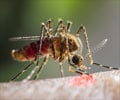Most of the time, the placenta is an effective barrier between the mother and her fetus. But Zika virus is able to overcome it.

‘A pair of studies have identified the transmission of Zika virus from the mother’s bloodstream into the fetus through the placenta, paving way for developing effective vaccines in near future.
’





A pair of studies, one published in the journal Cell and the other in Nature, could help scientists better understand the mosquito-borne infection and develop vaccines to prevent it. "This is the first demonstration in an animal model of in utero transmission of Zika virus, and it shows some of the same outcomes we've been seeing in women and infants," said Michael Diamond, a professor of medicine, molecular microbiology and pathology and immunology at Washington University in St. Louis and co-senior author of the study in Cell.
Mice were infected with a strain of Zika that was 97 percent similar to the kind circulating in Brazil, where thousands of babies are suspected of having been born with unusually small heads and deformed brains - a condition known as microcephaly - since last year.
In one of the experiments, researchers used pregnant mice that were genetically engineered to lack the ability fight off Zika. The virus killed most fetuses within a week, the study found. Offspring that survived had severely stunted growth.
In another experiment using genetically normal mice, the fetuses did not die but showed impaired growth and neuron damage.
Advertisement
In neither experiment did the mice develop microcephaly, but researchers said this could come down to biological differences between people and mice.
Advertisement
But researchers were particularly intrigued by the way Zika expanded inside the placenta, an organ that develops inside the uterus during pregnancy and nourishes the fetus.
Levels of Zika virus in the mouse placentas were 1,000 times greater than in the blood of pregnant mice.
"Most of the time, the placenta is an effective barrier between the mother and her fetus. But Zika is able to overcome it," said Indira Mysorekar, a co-senior author from Washington University School of Medicine.
"We see the virus in the fetal blood vessel lining and then in circulation, and soon after, we see that it's able to go to the brain."
Nature study
In a separate study, published in Nature, experiments with wild mice using the Zika strain sweeping across Latin America also showed that the virus can cross from placenta to fetus, causing irreparable nerve damage.
"This is the first work that confirms the cause and effect of the circulating Brazilian Zika virus," said senior author Alysson Muotri, an associate professor at the University of California San Diego School of Medicine.
The Cell study experiments used a slightly different strain.
In the lab, Muotri and colleagues also exposed human brain cells to the Zika strain thought to be responsible for some 1,200 confirmed cases of microcephaly in Brazil.
Using pluripotent "blank slate" stem cells, they created the kind of cells that form the brain's cerebral cortex. They also grew cerebral organoids, often described as "mini-brains" that resemble the embryonic human cortex.
In both cases, the virus attacked and killed the nerve cells, disrupting growth and normal development.
These results "suggest that the health impacts of Zika are likely more widespread that we have currently documented," Muotri told journalists in a telephone press conference.
"For me, this is the tip of the iceberg -- we should probably rename this 'congenital Zika syndrome'," to cover the full range of consequences, he said.
One of the many unanswered questions about Zika is how it mutated as it moved from Africa - where it originated and was discovered in monkeys in 1947 - to Pacific Asia and beyond.
The virus appears to have remained largely benign for humans until outbreaks in the islands of Yap in 2007, and in French Caledonia in 2013, the year it also reached Brazil.
The Nature team compared the impact of the African and Brazilian strains on chimpanzee organoids. Unlike for humans, the chimp brain cells were more vulnerable to the African variant.
"This suggests that the Brazilian strain has, somehow, adapted to humans," Muotri said.
Taken together, the experiments can be used as a "platform to test some therapeutic ideas, to try potential vaccines or drugs that can ameliorate or inhibit the virus," said co-author Jean-Pierre Peron, a researcher at the University of Sao Paulo.
Diamond added that both studies show that "all you need is the virus to be able to cause birth defects and congenital malformations. You don't need anything else. You dont have to invoke other factors, external, environmental or otherwise."
Outside expert Derek Gatherer, a lecturer in the Division of Biomedical and Life Sciences at Lancaster University, said the research "provides further evidence that Zika is the cause of microcephaly and other neurological and birth defects in humans."
Source-AFP












